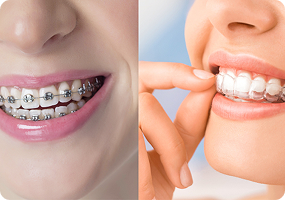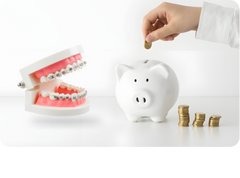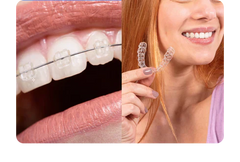Table of Content
A brief history of orthodontics
Braces have been helping straighten teeth for many years. In the early days of orthodontics, metal braces with brackets and wires were the only available option for teeth straightening. Over time, new types came out, like ceramic braces, braces that go behind your teeth (lingual braces), and braces that don't need elastic bands (self-ligating braces). These changes made braces more comfortable and better looking.
Then clear aligners changed everything. Around the early 2000s, they became popular. These transparent, removable trays made teeth straightening much less noticeable. They became a favorite for teens and adults as they fit better into everyday life. Since then, these have been the top reasons why you should go for aligners.
Aligner vs braces: The basics
Clear Aligners

Clear aligners are made from medical-grade plastic and are designed to fit your teeth exactly. They gently shift your teeth into the right place over time. You get a new set of trays every week or two as your teeth move.
Are You Eligible for Clear Aligners?
Take our 30-second assessment to see if clear aligners are right for you. It's quick, free, and the first step to your dream smile!

Braces

Braces are different. They involve metal or ceramic brackets glued to your teeth and connected with a wire. An orthodontist adjusts them every few weeks to shift your teeth. Braces come in different forms: traditional metal, less noticeable ceramic, hidden lingual ones, and self-ligating braces.
Cost considerations: Clear aligners vs braces
Cost plays a big role when deciding between braces and aligners. Braces usually cost between $3,000 and $7,000. Ceramic ones cost more, and lingual braces are the most expensive because they're a little more complicated to adjust. On the other hand, Caspersmile Clear Aligners start at $895. We also offer monthly payment plans, making our aligners even easier to afford while maintaining the high quality.
Start your journey to achieve a perfect smile with Caspersmile clear aligners.
Discover how discreet, affordable, and dentist-approved aligners can transform your smile.

Also, remember to consider additional costs such as retainers, dental visits, and possible replacements. Some dental insurances may cover part of the cost, so check your plan.
Appearance and aesthetics
Aligners are nearly invisible, which is why many people love them. They're great for anyone who doesn't want others to notice they're straightening their teeth. They don't show in pictures, during speeches, or in day-to-day life. Braces are more obvious, especially metal ones. Ceramic braces are closer to the color of your teeth, but they still have wires. Lingual braces are hidden behind the teeth but can be uncomfortable at first and affect how you talk.
Comfort and convenience
Aligners are smooth and don't have any sharp parts, so they're generally more comfortable. You can take them out when eating or brushing your teeth.
Braces, especially metal ones, can hurt when they're tightened. They might cause sore spots in your mouth. You also need to be careful while eating, so you don't break anything.
Aligners let you eat what you want, but you must wear them for 20 to 22 hours every day to work properly. If you forget or lose them, treatment can take longer.
Maintenance and oral hygiene
Aligners are easy to clean; just rinse and gently brush them. Since you take them out to brush and floss, keeping your mouth clean is easier.
Braces make cleaning harder. Food can get stuck around the brackets and wires, raising the risk of cavities and gum problems. You may need special tools such as tiny brushes or a water flosser to clean.
If you're super busy or a teen who finds it hard to stay on top of dental hygiene, aligners might be the simpler option.
|
Category |
Aligners |
Braces |
|
Cleaning Teeth |
Easy - remove trays to brush |
Difficult - brackets trap food |
|
Tray/Bracket Care |
Rinse trays daily |
Avoid sticky/hard food |
|
Dental Visits |
Every 6-8 weeks |
Every 4-6 weeks |
Treatment duration and effectiveness
Both braces and aligners can fix mild to serious dental problems. How long it takes depends on how complicated your case is and how well you follow instructions.
Braces are better for complex cases, such as fixing bite problems, crowded teeth, or teeth that need rotating. Treatment usually takes 18 to 36 months.
Clear aligners can correct mild to moderate alignment issues more quickly, often within 6 to 18 months. When worn as directed, they deliver faster, more precise results.
Lifestyle compatibility
Your lifestyle can help decide which option is best.
If you play sports, sing, or speak publicly, aligners are easier. There's no risk of injury from wires, and you can take them out for special moments.
Braces require extra caution, athletes often need a mouth guard, and playing certain musical instruments can feel awkward during the initial adjustment period. You'll also need to skip sticky or crunchy foods.
If you travel a lot or have a busy schedule, aligners are easy to manage. You can take your next tray with you and switch it without needing to visit the dentist right away.
Follow-up and supervision
Braces need regular visits to the orthodontist every 4 to 8 weeks. These check-ins help make sure everything's going well.
Aligners, particularly mail-order options, typically require fewer in-person visits, offering greater convenience for those with busy or remote lifestyles. Some companies offer check-ins through a phone app. If you're using in-office aligners like Invisalign, you'll still see your dentist, but less often than with braces.
Age and suitability
Braces work well for kids, teens, and adults. They're often recommended for younger kids because they don't have to remember to do anything extra.
Aligners are best for teens and adults who can stick to wearing them as directed. Some aligners are now made for kids, but they still require responsibility.
Social and psychological impact
Metal braces can make people, especially teens and adults, feel self-conscious. That might hurt their confidence or make them less outgoing.
Aligners help avoid that. Because they're invisible, people feel more confident during treatment.
That's another reason aligners are popular with working professionals or anyone often in the spotlight.
Environmental and ethical considerations
Some people worry that aligners create a lot of plastic waste. But many companies are now using recyclable materials and offering programs to send back used trays for recycling.
Braces are made from metal and other materials that also have an environmental cost. But because they don't need to be replaced every couple of weeks, they may produce less waste overall.
No matter which option you choose, you can help the environment by choosing a brand that cares about sustainability.
Braces vs clear aligners: Quick comparison
|
Feature |
Clear aligners |
Traditional braces |
|
Visibility |
Invisible/transaprent |
Highly visible (metal), less so (ceramic) |
|
Comfort |
Smooth and irritation-free |
May cause discomfort easily |
|
Removability |
Removable |
Fixed |
|
Oral hygiene |
Easy to maintain |
Harder to brush/floss |
|
Diet restrictions |
None (remove to eat) |
Yes (avoid sticky/hard foods) |
|
Treatment duration |
6-18 months |
12-24 months |
|
Follow-up visits |
Fewer (every 6-8 weeks) |
More frequent (every 4-6 weeks) |
|
Ideal for |
Mild to moderate cases |
For |
Why are clear aligners a top choice today?
When comparing clear aligners and braces, it's easy to see why more and more people are choosing aligners. Here are the reasons why aligners are best:
Convenience
One of the best things about clear aligners is that you can take them out whenever you need to eat, drink, brush, or floss. This makes daily routines much easier. To get the best results, they should be worn for at least 22 hours a day.
Discreet Appearance
Aligners are practically invisible when you wear them, so most people won't even notice you have them on. This makes them a great choice for anyone who wants to straighten their teeth without the obvious look of metal braces.
Comfort
Aligners are smooth and gentle on your mouth. They don't have wires or brackets that can poke or irritate your cheeks and gums. Also, putting them in is simple and usually pain-free.
Simple to Clean
Keeping clear aligners clean is quick and easy. They are easy to rinse and brush, unlike braces, which require extra effort each day to prevent food and plaque from getting trapped around brackets and wires.
Introducing Caspersmile Clear Aligners for teeth straightening

Say hello to a more confident you with Caspersmile Clear Aligners, the smart, budget-friendly way to straighten your teeth without dealing with metal braces. These aligners are designed to be comfortable, discreet, and effective, all while fitting into your daily routine and your budget. Whether you're working, working out, or just living your life, Caspersmile clear aligners fit right in, no wires, no interruptions. Finally, you can achieve the smile you've always wanted, in a way that works for you.
How does it work?
Wondering do aligners work for real? The answer is yes, when used correctly and consistently, clear aligners are highly effective for treating a wide range of orthodontic issues.
Here's the breakdown of whether aligners work:

Final takeaways: Straighten your teeth the smart way
In today's busy world, more people are looking for simple, effective ways to improve their smile without dealing with the hassle of metal braces. Caspersmile Clear Aligners have completely changed the way we straighten teeth. They're subtle, easy to remove, and designed to fit into your everyday life. You can eat, brush, and go about your day without any major changes, all while your teeth gently shift into place. Whether you're a working professional or a student, clear aligners are quickly becoming the preferred choice for those who want a good-looking smile with minimal effort.
Also, they're delivered straight to your door. With Caspersmile, you can get the smile you've always wanted, without the big price tag or the inconvenience. It's a solution that fits your budget, your routine, and your goals.
Frequently asked questions

References
Tamer, İ., Öztaş, E., & Marşan, G. (2019). Comparison of the effectiveness of clear aligners and fixed appliances on patients' oral health-related quality of life: A randomized controlled trial. European Journal of Orthodontics, 41(1), 62-67. https://doi.org/10.1093/ejo/cjy032
Robertson, L., Kaur, H., Fagundes, N. C. F., Romanyk, D., Major, P., & Flores-Mir, C. (2020). Effectiveness of clear aligner therapy for orthodontic treatment: A systematic review and meta-analysis. Orthodontics & Craniofacial Research, 23(2), 133-142. https://doi.org/10.1111/ocr.12314
White, D. W., Julien, K. C., Jacob, H. B., Campbell, P. M., Buschang, P. H. (2017). Discomfort associated with Invisalign and traditional brackets: A randomized clinical trial. The Angle Orthodontist, 87(6), 801-808. https://doi.org/10.2319/012517-78.1
Subscribe our newsletter
By clicking subscribe, you agree to our Privacy Policy and opt in to receive communications from Caspersmile. You can unsubscribe at any time.





